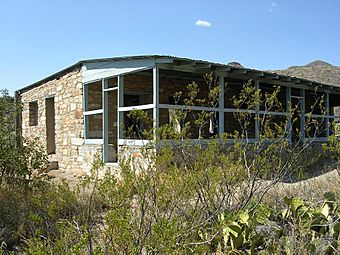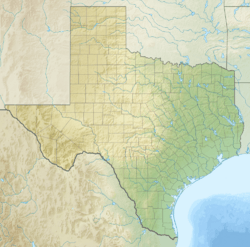Homer Wilson Ranch facts for kids
Quick facts for kids |
|
|
Homer Wilson Ranch
|
|

Homer Wilson House
|
|
| Nearest city | Santa Elena Junction, Texas |
|---|---|
| Area | 200 acres (81 ha) |
| Built | 1929 |
| NRHP reference No. | 75000153 |
| Added to NRHP | April 14, 1975 |
The Homer Wilson Ranch, also called the Blue Creek Ranch, was one of the biggest ranches in Texas in the early 1900s. It is now part of Big Bend National Park. Homer Wilson started this ranch in 1929. It was located near Oak Springs, west of the Chisos Mountains.
History of the Ranch
Homer Wilson created the ranch in 1929. It grew to be very large, covering more than 28,000 acres. This land was bought by the State of Texas in 1942. It became part of the new Big Bend National Park.
A big part of Wilson's ranch used to be the old G4 Ranch. This older ranch was started by John and Clarence Gano in the 1880s. Homer Wilson's ranch mainly raised sheep and goats. It was the first big operation of its kind in the Big Bend area.
Wilson lived at the ranch until he passed away in 1943. His family moved away the next year. Homer Wilson was born in Del Rio, Texas in 1892. The Homer Wilson Ranch was one of the largest ranches in Texas. It was also the most important ranch in the Big Bend area.
The Ranch House
The main house at Blue Creek was about 24 feet wide and 60 feet long. It had a screened porch on the south side. This porch was about 16 feet wide and 60 feet long.
The house had one story. It included two bedrooms, a living room, and a kitchen. There was a large fireplace in the center of the house. The roof was special because it had two layers. The inside layer was a traditional reed roof, common in that area. Above it was a sheet metal roof. Another building nearby housed the ranch workers. These buildings were left empty when the Wilson family moved out.
National Recognition
The Blue Creek area of the Homer Wilson Ranch was added to the National Register of Historic Places. This happened on April 14, 1975. Being on this list means the place is important for its history. It helps protect it for future generations.



